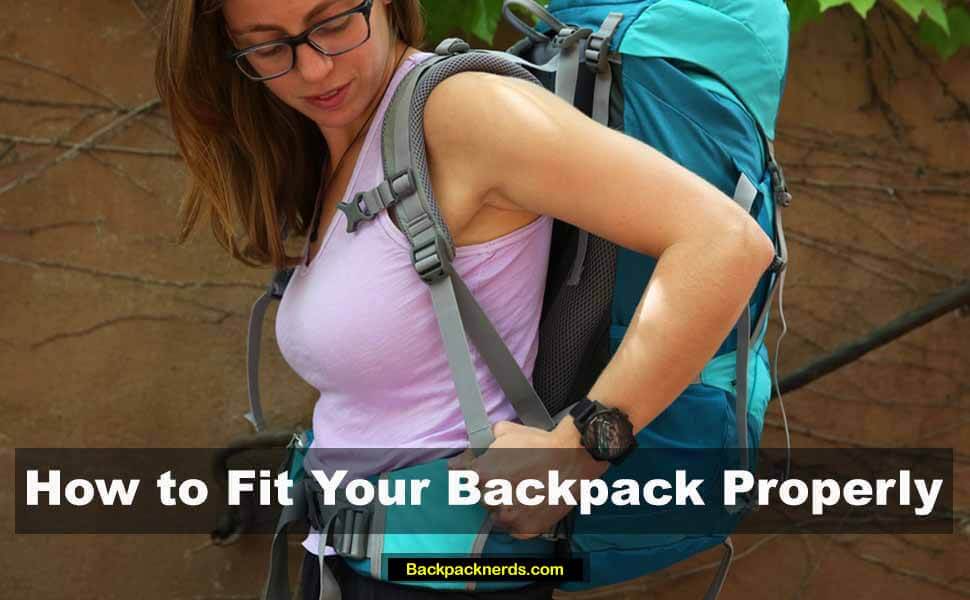Fitting your backpack properly is essential for a comfortable and enjoyable hiking experience. A poorly fitting backpack can cause discomfort, fatigue, and even injury. By taking the time to adjust your backpack to your body, you can ensure that the weight is evenly distributed and the pack feels snug and secure. That’s why you need to know how to fit your backpack properly. In this guide, we will walk you through the steps for properly fitting your backpack, including adjusting the shoulder straps, hip belts, load-lifter straps, sternum straps, and compression straps. Whether you’re going on a day hike or a multi-day backpacking trip, following these steps will help you achieve a comfortable and secure fit for your backpack.
Since fitting your bag on your back properly is crucial for ensuring a comfortable and safe hiking experience, you should know the steps of properly fitting your pack.
How to Fit Your Backpack Properly
Here’s a step-by-step guide to how to properly fit your pack:
- Choose the right size pack: Make sure you choose a pack that fits your torso length and waist size. Most packs come in different sizes, so refer to the manufacturer’s sizing chart and measurements before purchasing.
- Loosen all straps: Before you start adjusting the pack, loosen all straps, including the shoulder straps, hip belt, and load-lifter straps.
- Put on the pack: Put on the pack and adjust the shoulder straps so that they sit comfortably on your shoulders. Adjust the sternum strap so that it sits comfortably across your chest.
- Adjust the hip belt: The hip belt should sit snugly on your hips, with the center of the belt over your belly button. Tighten or loosen the hip belt until it fits comfortably and snugly.
- Adjust the load-lifter straps: Load-lifter straps help to transfer the weight of the pack from your shoulders to your hips. Adjust these straps so that the pack feels balanced and the weight is evenly distributed.
- Adjust the shoulder straps: Adjust the shoulder straps so that they sit comfortably on your shoulders without digging in or rubbing.
- Adjust the compression straps: Compression straps help to stabilize the load and reduce the pack’s volume. Adjust these straps so that the load is stable and the pack is snug against your back.
- Make final adjustments: Walk around with the pack on and make any final adjustments to the straps as needed. The pack should feel comfortable and stable, with the weight evenly distributed.
- Pack your gear: Once you have the pack properly fitted, pack your gear, making sure to distribute the weight evenly. Keep heavier items close to your back and lighter items toward the top and bottom of the pack.
- Test it out: Take your fully packed pack for a test walk to ensure that it feels comfortable and that the weight is evenly distributed. Make any final adjustments as needed.
By following these steps, you can properly fit your pack for a comfortable and safe hiking experience.
Read More Articles:
- Backpack Size Guide
- Luggage Size Guide
- How to Wear a Sling Bag?
- Backpack Checked Luggage
- How Big is a 20 Liter Backpack?
What Are The Importance To Fit Your Pack Properly?
Buying the right pack for your body type is crucial for ensuring that the pack fits properly and is comfortable to wear for an extended period of time. A properly fitting pack distributes the weight of the load evenly across your shoulders, hips, and back, which makes it easier to carry heavier loads and reduces the risk of injury or strain.
However, a pack that is too large or too small can cause discomfort and pain, especially on longer hikes, and can throw off your balance, making it harder to maintain your footing on uneven terrain. A pack that fits properly is also more stable on your back, reducing the risk of the pack shifting or bouncing as you walk.
Additionally, a pack that fits properly can help you maintain good posture, which is important for reducing fatigue and strain on your back and neck. That’s why buying the right pack for your body type is essential for ensuring a comfortable and safe hiking experience.
What Length Backpack Do I Need?

The length of the backpack you need will depend on several factors, such as your torso length, the intended use of the backpack, and personal preferences.
To determine your torso length, you can measure from the base of your neck to the top of your hip bones. This measurement can be used to help determine the appropriate backpack size.
Generally speaking, backpacks come in different sizes based on their volume capacity, which is measured in liters. The appropriate size for you will depend on how much gear you plan to carry.
As a general guideline, if your torso length is less than 18 inches, a small backpack (less than 40 liters) may be appropriate. For torso lengths between 18 and 20 inches, a medium backpack (between 40 and 60 liters) may be suitable. For torso lengths greater than 20 inches, a large backpack (over 60 liters) may be appropriate.
It’s important to note that these guidelines are not absolute, and personal preferences and the intended use of the backpack can also affect the appropriate size. It’s always a good idea to try on backpacks in person and test their fit and comfort before making a purchase.
How to Adjust a Backpack Correctly?

Adjusting a backpack properly is crucial to ensure comfort, stability, and weight distribution.
Firstly, start by adjusting the shoulder straps so that they sit snugly on your shoulders. Avoid having the straps too tight or too loose, as this can cause discomfort and strain.
Secondly, adjust the chest strap and hip belt to keep the backpack close to your body and centered on your back. This will help distribute the weight evenly and prevent the pack from sagging or pulling you backward. The hip belt should sit on your hips, not on your waist, to transfer most of the weight from your shoulders to your hips.
Finally, adjust any additional straps, such as load lifters, to further fine-tune the fit of your backpack. Remember to test your adjustments before hitting the trail to make sure everything feels comfortable and secure.
With the proper adjustments, your backpack will feel like an extension of your body and allow you to hike comfortably for hours on end.
What Are The Top Straps On A Backpack For?
The top straps on a backpack serve several purposes.
Firstly, they help to compress the contents of the backpack, making it more streamlined and reducing the overall volume. This is useful when carrying a partially loaded pack or when trying to reduce the pack’s profile.
Secondly, the top straps help to stabilize the load and prevent it from shifting around inside the backpack. This is particularly important when hiking on uneven terrain or scrambling up steep hills.
Thirdly, the top straps can be used to attach additional gear or items to the outside of the backpack, such as a sleeping pad, tent poles, or a jacket. This can free up space inside the backpack for other items or make it easier to access frequently used items.
Finally, some backpacks have a daisy chain or webbing system on the top straps, which allows for even more customization and attachment options.
Overall, the top straps on a backpack are a versatile and essential component that helps to improve the pack’s stability, organization, and functionality.
What Are Chest Straps On Backpacks For?

Chest straps on backpacks serve several important functions.
Firstly, they help to stabilize the load and prevent the backpack from bouncing or shifting around while walking or hiking. This is particularly important when carrying heavier loads or when moving over uneven terrain.
Secondly, chest straps help to distribute the weight of the backpack more evenly across the body, reducing the strain on the shoulders and upper back. This can help to prevent fatigue and discomfort during long hikes or extended periods of wear.
Thirdly, chest straps can help to improve the overall fit and comfort of the backpack, by pulling the shoulder straps closer together and reducing the gap between the shoulders and the backpack. This can help to improve the backpack’s balance and reduce the risk of back pain or injury.
Finally, some backpacks have adjustable or elastic chest straps, which can be customized to fit different body types or to accommodate changes in clothing or gear.
Overall, chest straps are an important feature of many backpacks, and they can greatly improve the backpack’s stability, comfort, and performance.
Final Words
In conclusion, Proper backpack fitting is key to a comfortable outdoor experience. Adjust the shoulder straps, hip belt, chest strap, and top straps to evenly distribute weight, stabilize the load, and reduce strain. When fitted correctly, your pack should feel like part of your body, letting you hike for hours with ease. Always test and tweak before hitting the trail to ensure the perfect fit.
Read More Articles:
- How Big is a 40 Liter Backpack
- How to Measure Luggage
- How Big Is a 30 Liter Backpack
- North Face Recon vs Borealis
- How Many Books Can You Put In an Empty Backpack
- How to Remove Embroidery from a Backpack
- Can You Wash Pottery Barn Backpacks
Image Credit: Outsideonline

